
Gentle (r)evolution
Life in eco-communities
2022-
“Never doubt that a small group of thoughtful committed individuals can change the world. In fact, it’s the only thing that ever has.” /Margaret Mead/
By examining a radical lifestyle experiment, I would like to reflect on two issues of our time becoming extremely urgent – the fragile relationship between humans and nature and the importance of communities. Eco-communities are mainly created by intellectuals moving out of cities. Changing their lifestyle is not motivated by economic interests, it is rather a reaction to the negative processes around us. In an alienated world that is unhealthily overconsuming and eviscerating both the environment and the human spirit, they envision their future in a cohesive community. Their concept is based on localism. They want to live, make a living, trade, and relax locally. They reject the consumer society’s perception of accelerated time and the view that growth always means development.
They are committed to a life that is small-scale, slower, striving for self-sufficiency, sustainable in the long term, and community- based. They see themselves as part of natural processes and cycles. They use chemical-free farming, use nature-friendly technologies in their architecture and waste management, and save natural resources. They use farming practices that are adapted to the landscape, with local plant and animal species, and revive small crafts. They know the capabilities of their areas – as well as the physical environment and the cooperation and needs of the people living there. In their activities, they plan for tens of years ahead.
The number of people living in ecovillages in Hungary is currently a few hundred. This is not a dominant part of the Hungarian society, but I think it is still important to present them. Their difficulties are also barometers of the countryside’s difficulties (economic resources, local livelihood). It is also important to mention the proactivity of eco-communities: they not only formulate social problems but are also able to realize their plans for improvement in practice, providing concrete examples. Their results can also benefit society as a whole. Many of those moving out are agricultural engineers, ecologists, biologists, botanists, IT specialists, economists, psychologists, and communities are strengthened by several artists too. With their reflexivity, social critique, and open-minded approach to alternative solutions, they are capable of constant renewal. These communities are also constantly changing, learning their new way of life through practice.
There are both newcomers and leavers.
In the last year or so, I have visited three small communities in Transdanubia: Nagyszékely, Nyim and Krishna Valley. I have photographed at tree plantings, permaculture designer courses, stove-building workshops, and meetings of people striving for an ecological lifestyle alternative. I captured volunteers coming from abroad, a day in the life of community members, or the stages of building a straw-bale house.
Besides everyday life, they also expect me as a friend for their holidays: I said goodbye to the old year and hello to the new one with the Nyim Eco Community.


The Nyim Eco Community and volunteers planting a tree on the Eco-meadow on February 19, 2022. As a result of ten years of systematic work, the group has succeeded in establishing several groves and orchards on their jointly owned Eco-meadow. Part of the twenty-six hectares of degraded former agricultural land on the outskirts of the village is slowly turning back into natural meadow and forest, and part is being cultivated in an ecological way and transformed into their future habitat.

Cili, a member of the community, jumps on the collected rotten and pruned branches to chop them into smaller pieces and place them as mulch on the plates of the planted trees, thus protecting the base of the trees from the sun and creating a suitable environment for the seedlings to germinate. No extra resources are needed for chopping - if the wood is dry and old enough, it becomes brittle; no grinding is necessary. Until it becomes mulch, the pile provides a habitat for various animals. Nyim, February 19, 2022.
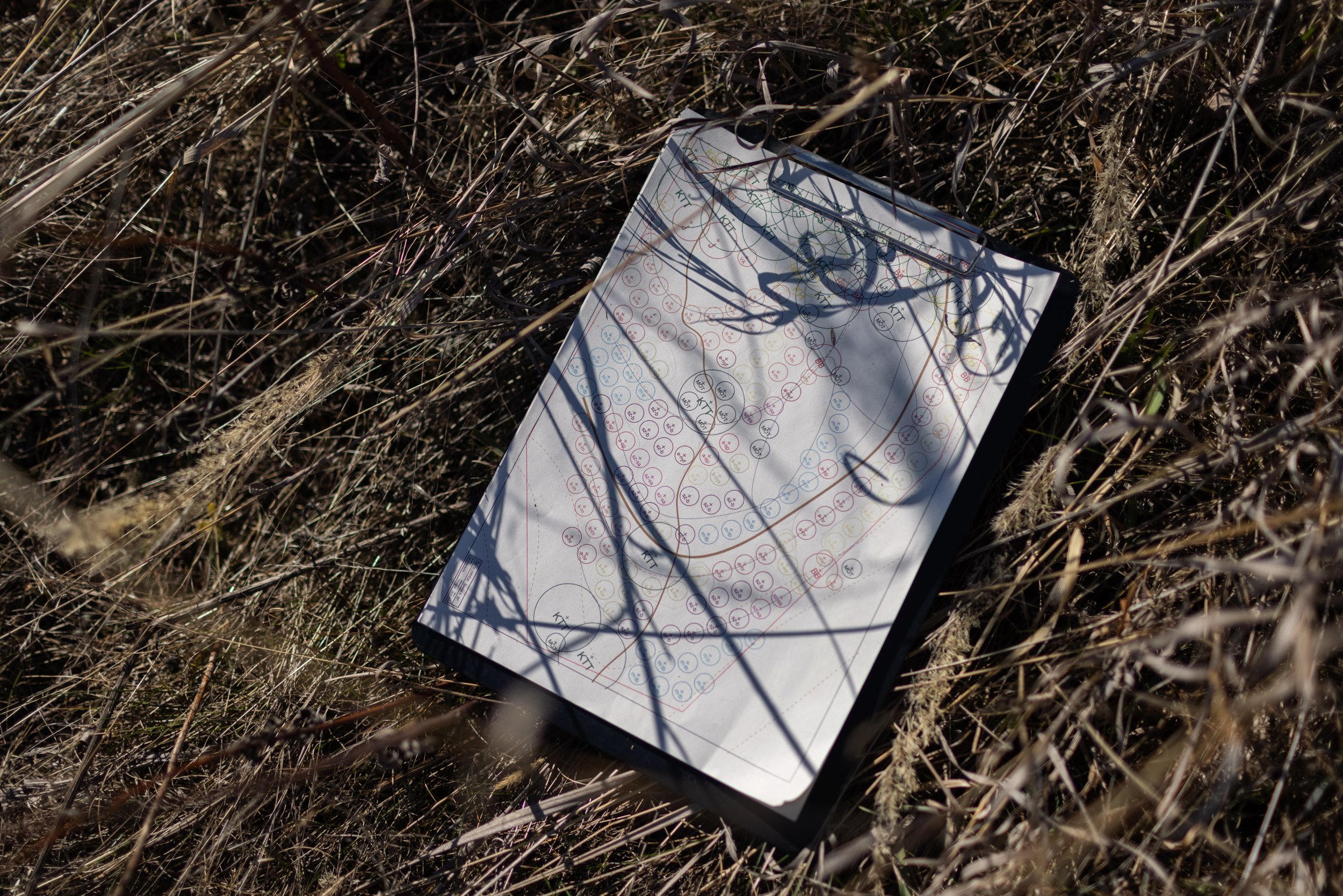
Tree planting plan in Nyim, on March 13, 2022.

Cili jumping on the electric tractor as a stowaway on the Eco-meadow in Nyim, on March 13, 2022. Gergő, a member of the community, built the engine of a small electric car into his existing work machine. The vehicle – as part of a sustainable system – is powered by the extra energy provided by the solar panels installed in Gergő’s house. It is a major help in the daily work of the community and is used for, among others, earth-moving and transporting irrigation water, saplings, and tools.

Little boy playing in the straw on the Eco-meadow in Nyim, on February 19, 2022.

Village children are very free to spend their leisure time. They often help out with community work, but they may also disappear for hours in the forest. There is minimal car traffic in the village, and the older children usually look after the younger ones anyway. Nyim, February 19, 2022.

Three members of the Nyim Eco Community marking the locations of the future trees on the Eco-meadow on the outskirts of Nyim on March 13, 2022. The group planted 1,200 trees – forest saplings and landrace fruit trees – during the last season, from autumn to spring. Since 2021, plantings have been organized in partnership with the 10 Million Trees Foundation team.

View from the eco house under construction. Nyim on March 13, 2022.

Sonja meditating on the floor of a straw bale house overlooking the Eco-meadow in Nyim on July 3, 2022. The Finnish volunteer spent six months with the community in Somogy County in the framework of the ESC (European Solidarity Corps) program, learning about their activities and philosophy through experience. Although the members have many ways of looking at the world, they do not follow a common religion, but together they experience a sense of belonging to nature. The young volunteers joining them can learn the practices and ideological background behind chemical-free food production, construction, and waste management that do not want to harm nature.

A member of the community and volunteers shovel clay and soil into a pit previously dug for mixing adobe on the Eco-meadow in Nyim on July 3, 2022. Last summer, making adobe was a recurring weekend activity for the community.

Painted toenails and muddy clay from adobe trampling on a brickmaker’s feet in Nyim on July 3, 2022. The clay, mixed with water, earth, and straw, was first kneaded together by trampling barefoot, then the mixed material was slammed into a wooden frame and smoothed down. The adobe bricks, dried in the sun for a week or two, were used to build the brickwork of the community’s eco-house.

Straw-bale house under construction in Nyim on July 3, 2022. The team’s long-term plan is to build low-energy houses on the meadow using local materials and to move out of the village to settle here and practice ecological farming. They started building their first eco-house in 2021, which is planned to become a community center.

Straw-bale house under construction in Nyim on September 25, 2022. The residential building was designed by Gabriella Révész, president of the Hungarian Strawbale-Building Association, considering the needs and ideas of the community. They build it with their own hands, using straw-bales and adobe. The community can learn how to do this at training sessions organized with the Strawbale-Builders.

György Guti voluteer measuring the distance of straw-bales of the straw and mud house under construction in the outskirts of Nyim on September 25, 2022.

A member of the Nyim Eco Community smooths the clay plaster being prepared by hand in Nyim on September 25, 2022.

Virág pushing a little girl in a wheelbarrow in Nagyszékely on August 9, 2022. Even amid a tiring weekday – in this case, the renovation of an adobe building – you can still have fun. The cellars carved into the loess wall in the background are also used for storing crops or housing small livestock.
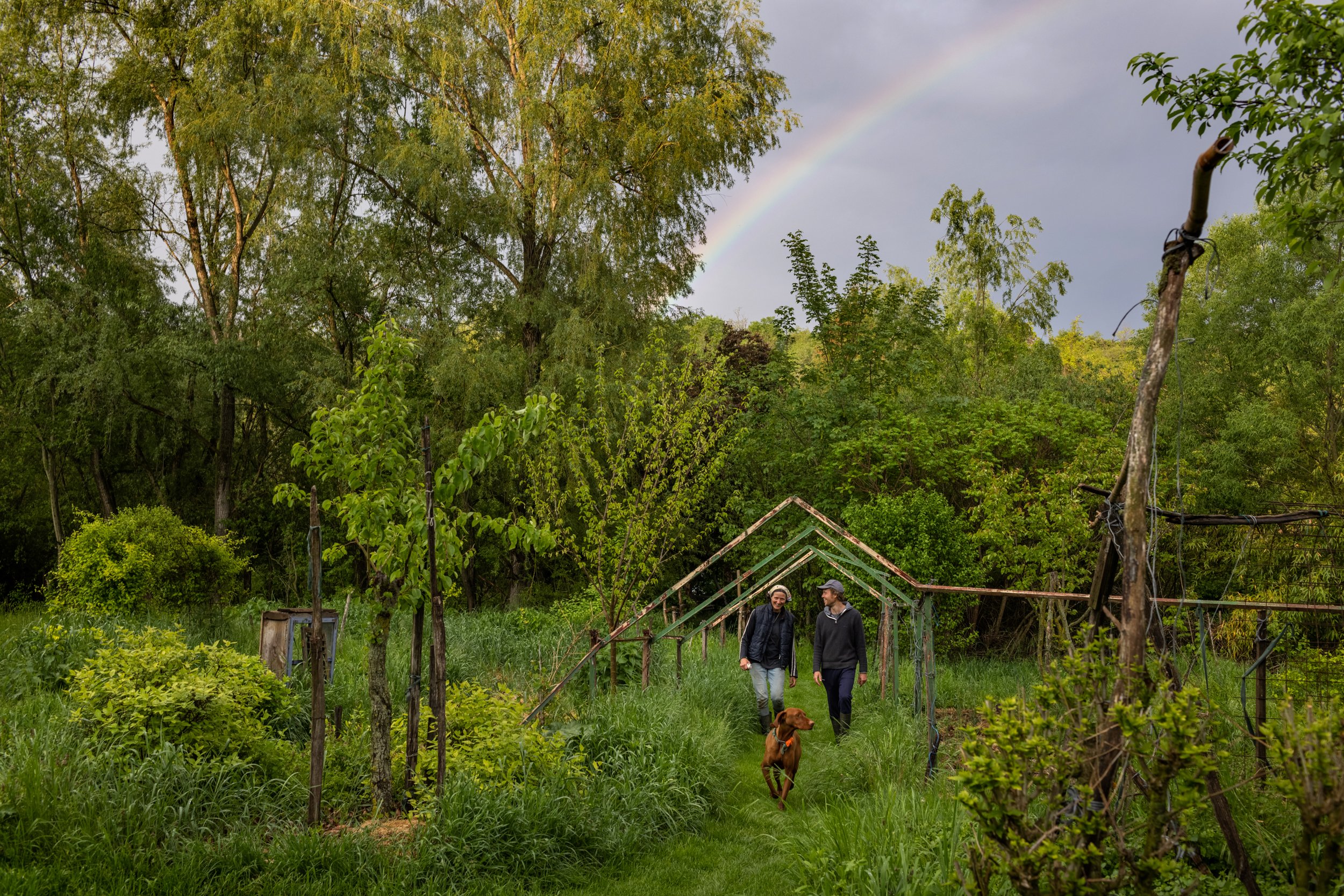
The spring is still incredibly green in Nagyszékely. May 9, 2022.
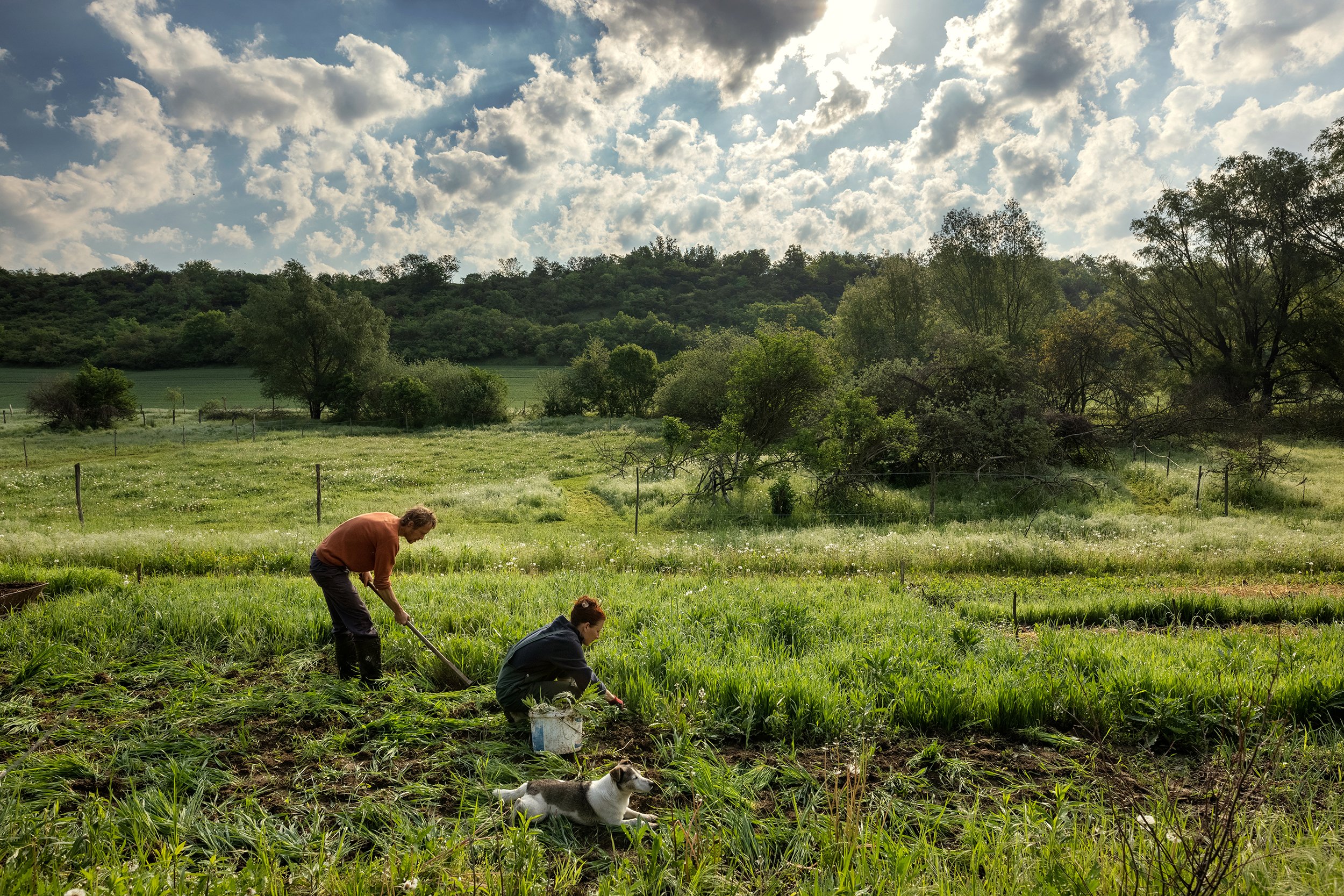
Belgian volunteers weeding in Nagyszékely on May 11, 2022.
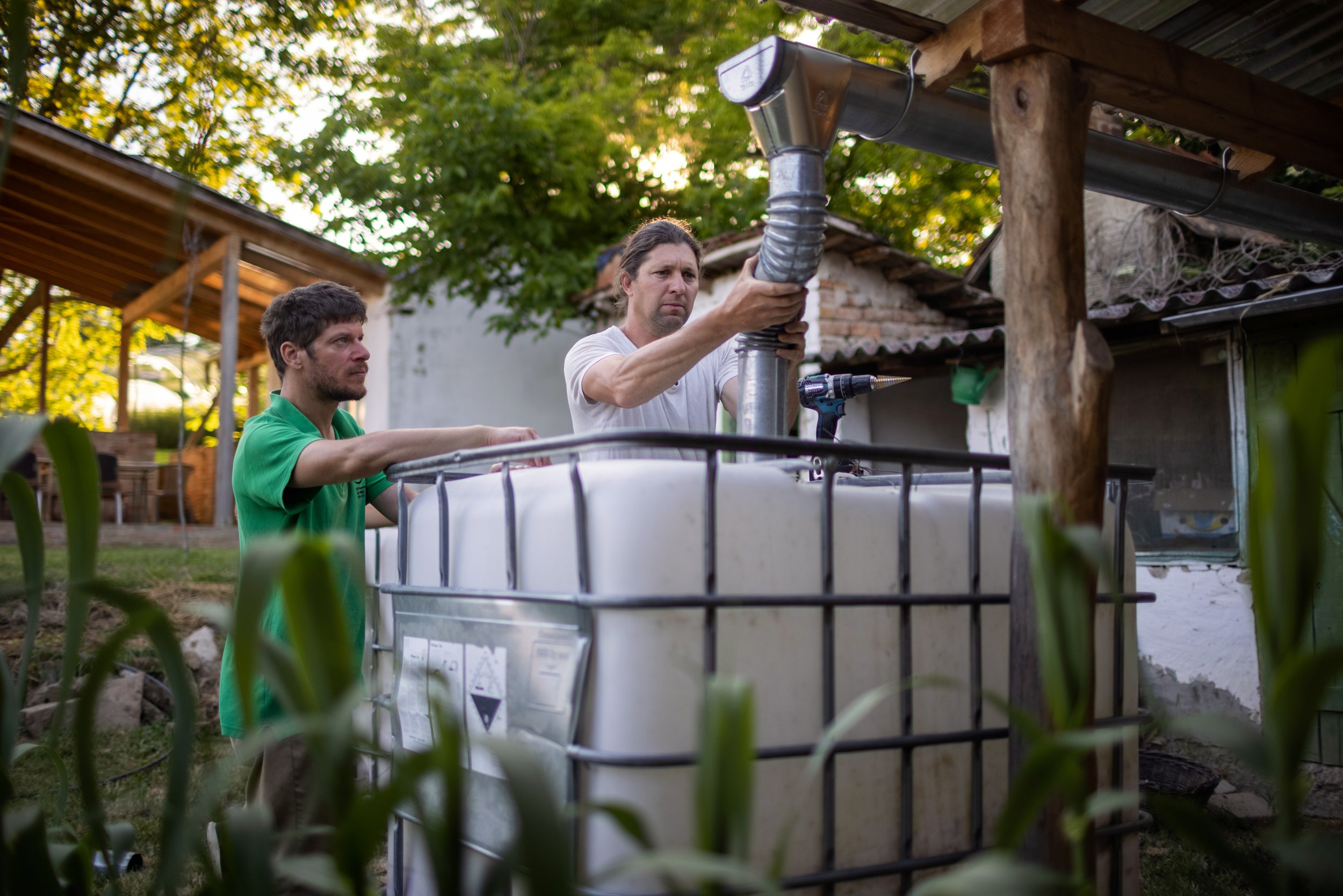
To catch and utilize rainwater, Gergő and Dani install water collection tanks at the community center in the village. Nyim, May 22, 2022.
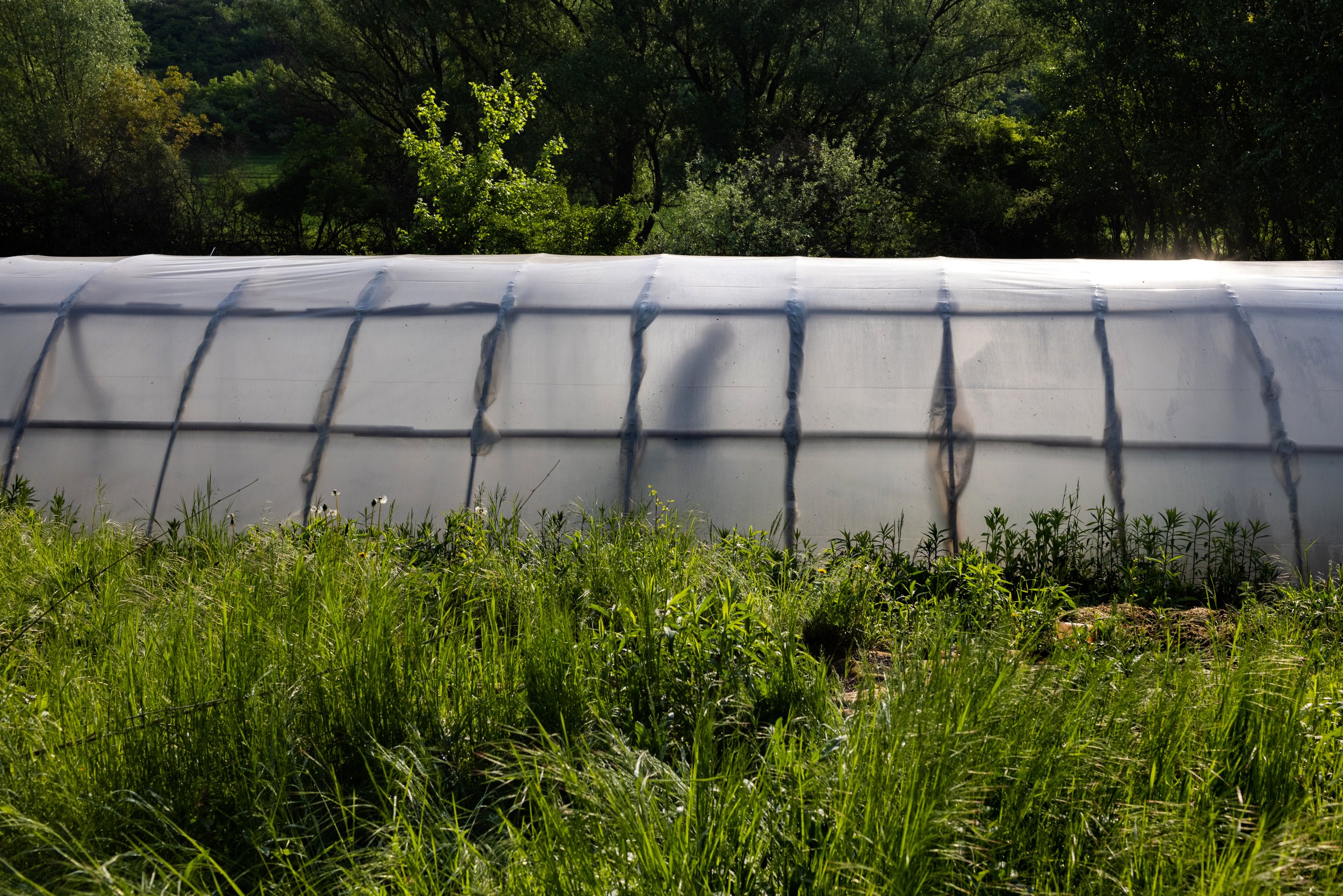
Active spring landscape in Nagyszékely on May 10, 2022.
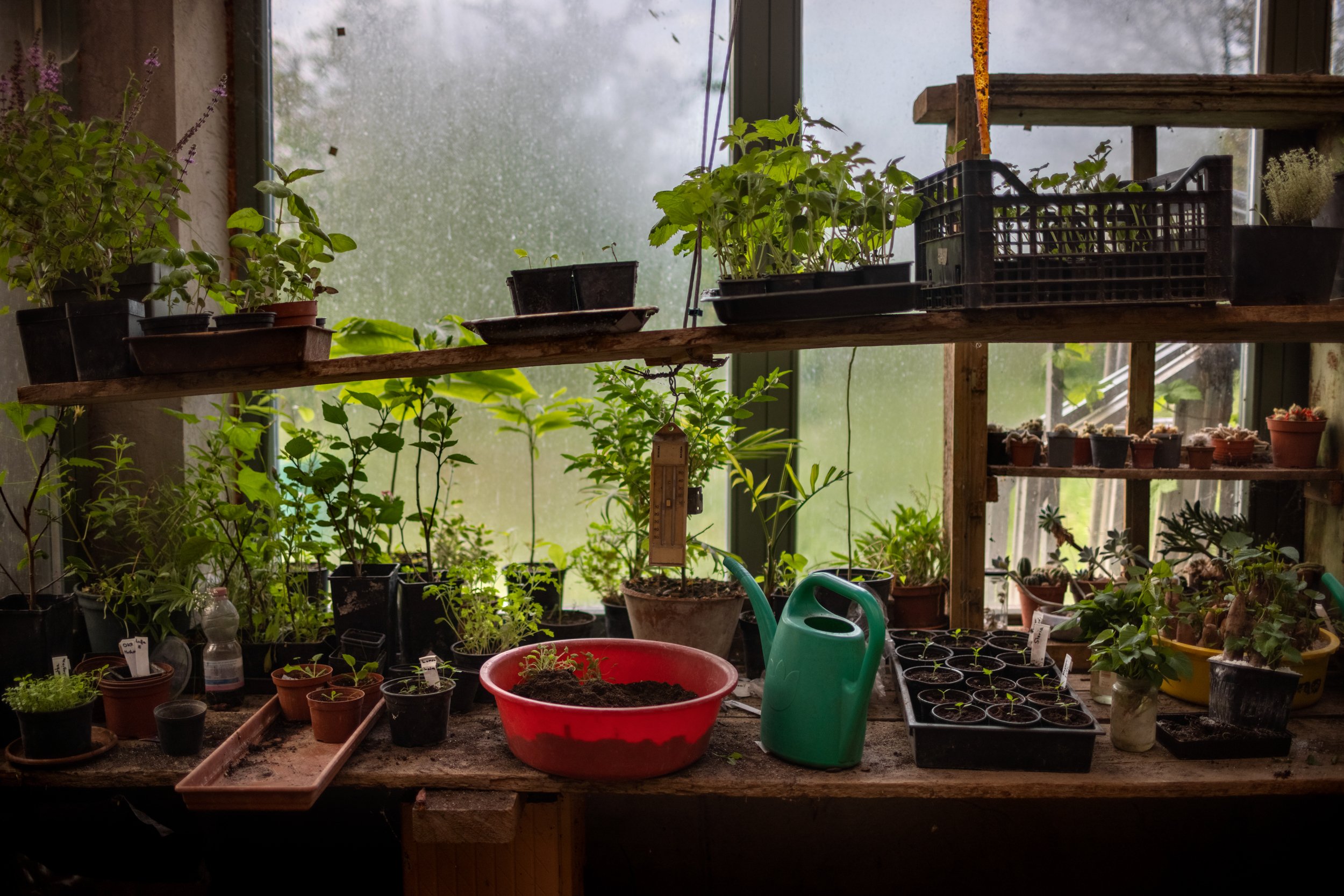
Still-life in the spring greenhouse. Nagyszékely, May 10, 2022.

Etelka picking lettuce in her greenhouse tent in Nagyszékely on May 11, 2022. In her daily work, she puts her botanical knowledge from the University of Horticulture to good use. She is a recognized expert in permaculture, and she is often called upon for advice by other farmers. Work cannot stop even while she is talking, so her phone and headset are always hanging in her bag.
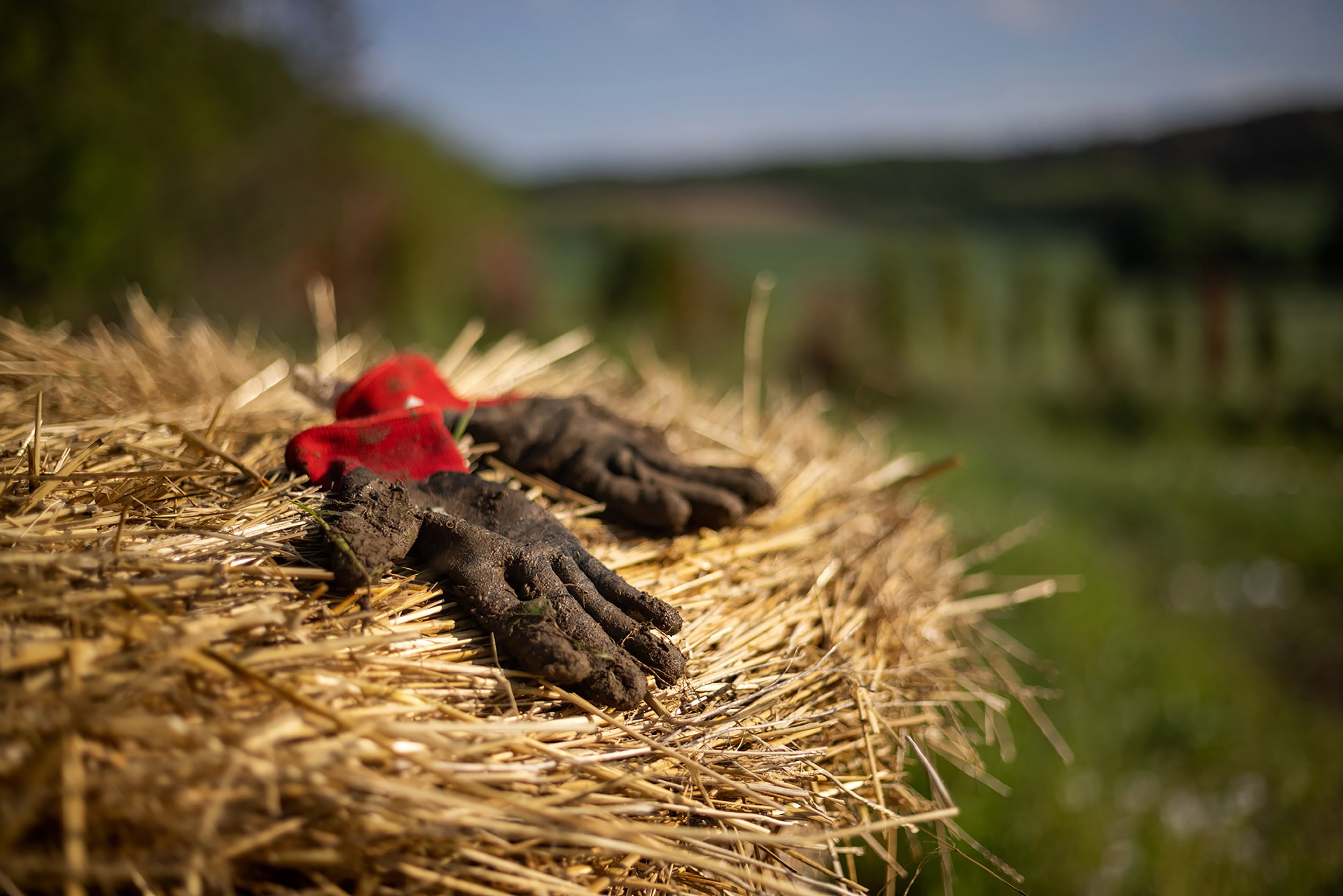
Gloves. Nagyszékely, May 11, 2022.

Dani planting tomato seedlings in the garden of their village house in Nyim on May 23, 2022. He covers the soil with hay and other organic matter from the garden: the mulch with the right carbon-to-nitrogen ratio helps to bind and retain moisture, nourishes the plant, and contributes to weed control. Although the garden may look untidy to an outsider spectator, Dani, an ecologist by training, and his wife are using permaculture principles to shape it. Chemical-free, sustainable plant production builds on biodiversity, avoids disturbance of the soil, uses consciously selected groups of plants, and thinks in terms of years or decades.
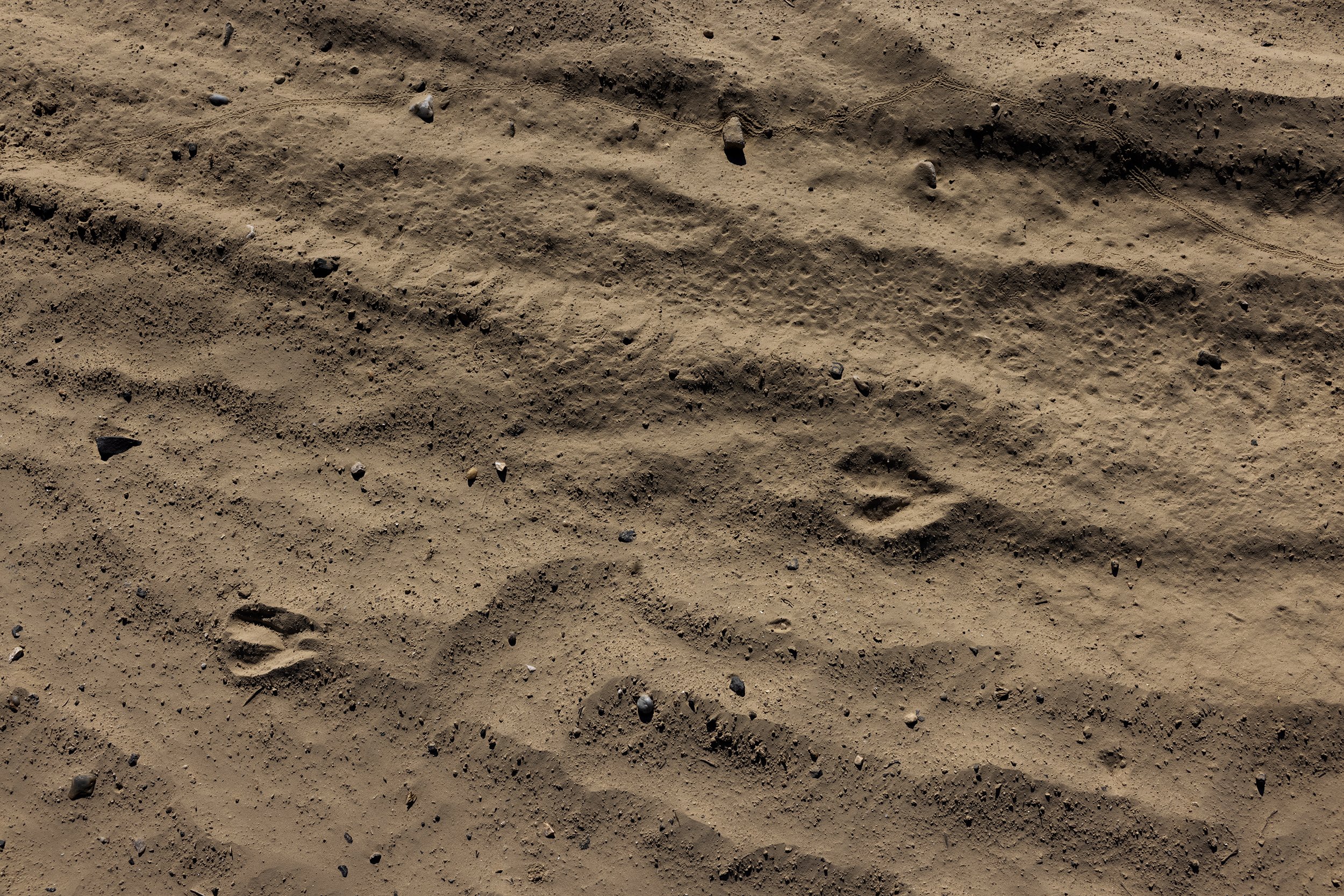
Animal footprints in the dirt in Nagyszékely on March 22, 2022. There was hardly any precipitation in the area in the spring. The drought and the occasional torrential rain made both animal care and planting difficult.
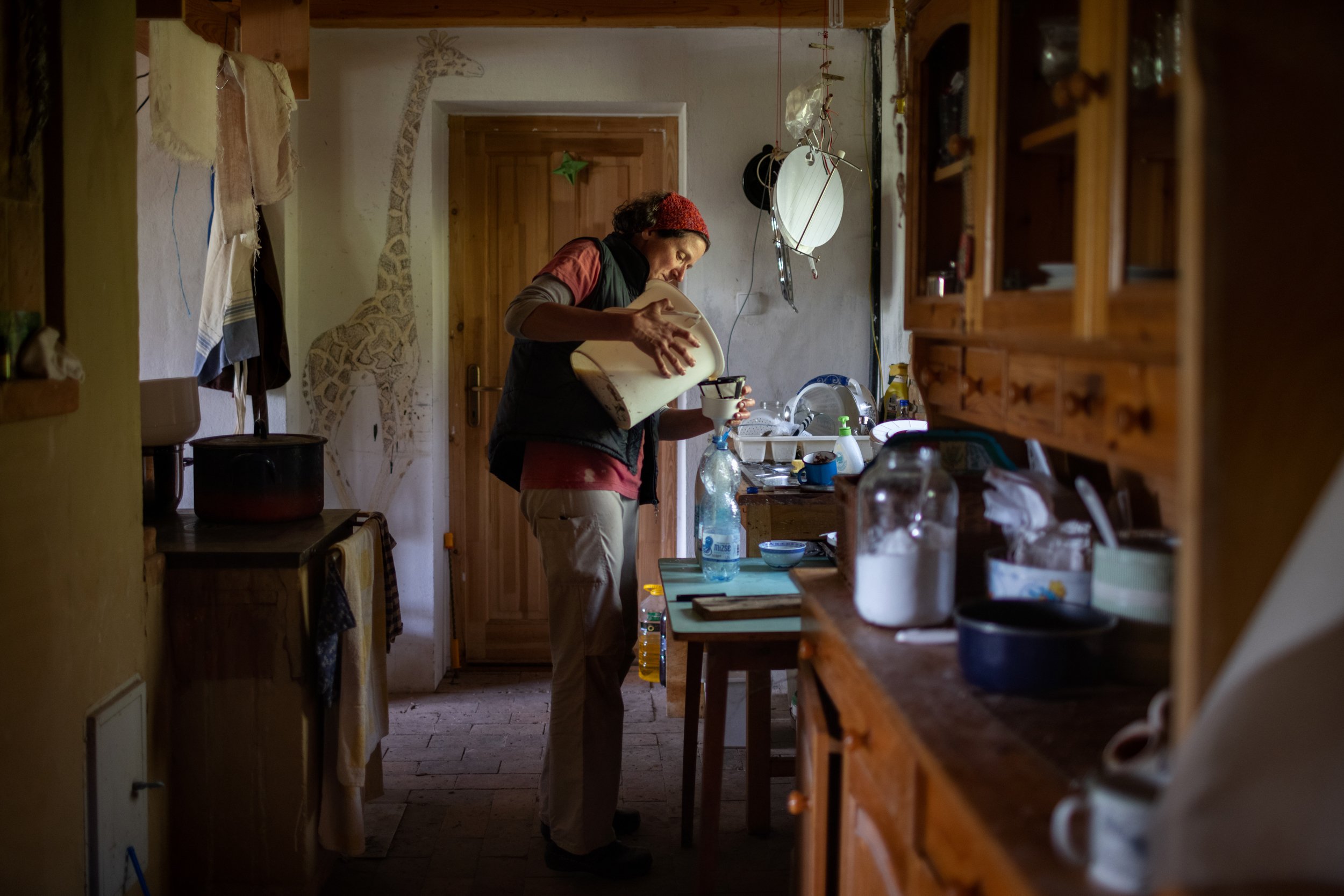
Etelka dispensing fresh milk in her kitchen in Nagyszékely on May 11, 2022. She and her daughters moved from the capital to the village in 2008, where they set up for self-sufficiency in food. Through experience and overcoming many difficulties, they have developed a complex farming system based on the local ecosystem. Waste management and water management are also important parts of this, alongside crop and livestock production. They eat seasonally, predominantly consuming what grows in their gardens. Milk, cheese, yogurt, eggs, dried fruits, and preserves are plentiful on the table in all seasons.
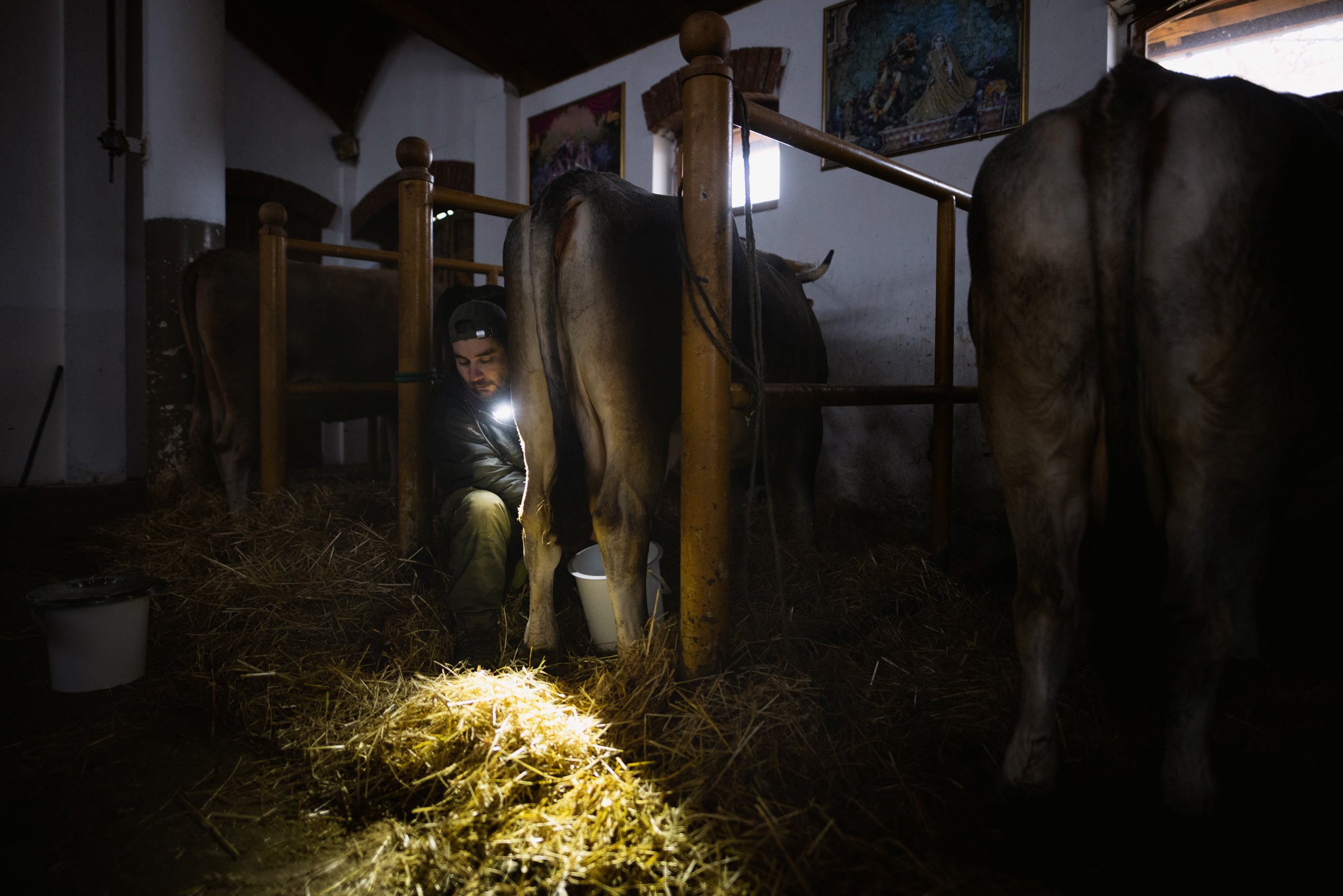
A bhakta (Krishna conscious believer) milking cows by the light of a headlamp on January 16, 2023, in the Krishna Valley, Somogyvámos. The vegetarian community cares for animals for their milk. All cattle have a name and are not sent to the slaughterhouse in their old age, they can stay on the organic farm until their natural death. The oxen are used by the community for farming and transporting goods.
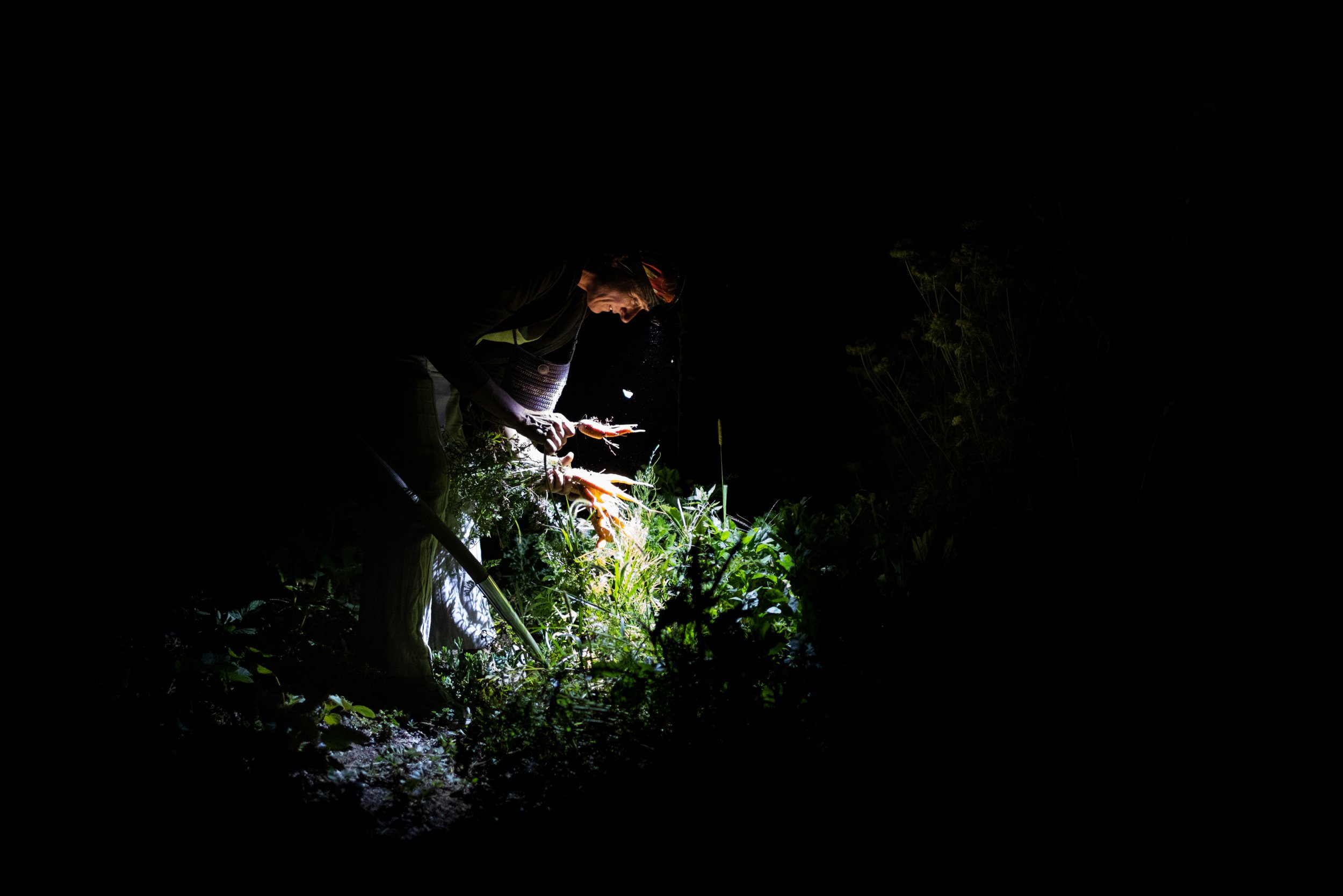
Etelka collecting carrots for the next day’s lunch in her garden in Nagyszékely on the night of August 15, 2022. No matter how long the summer days are, there are always more tasks on the farm than can be done during the day.
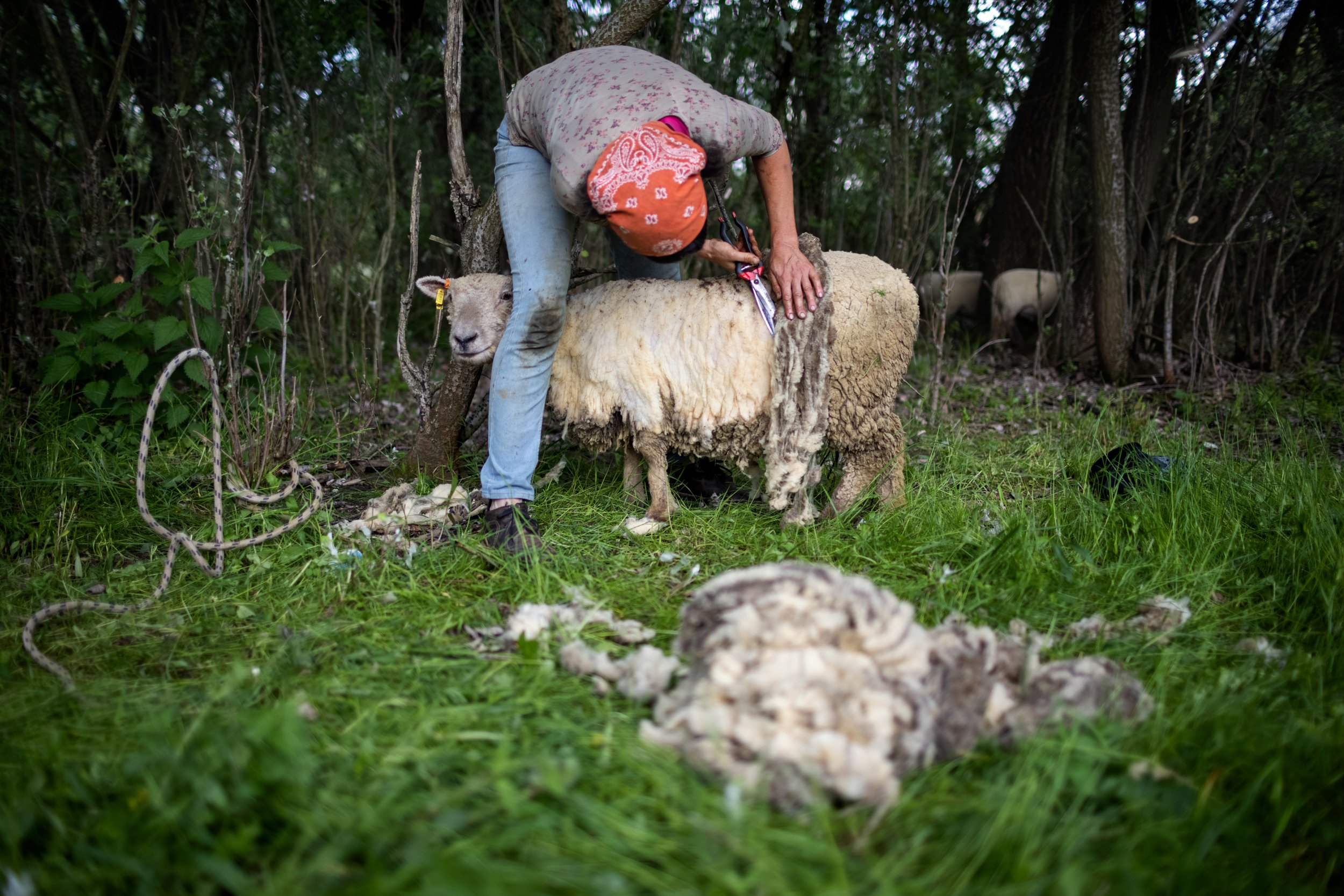
Etelka shearing her sheep gently, by hand, in Nagyszékely on May 10, 2022.
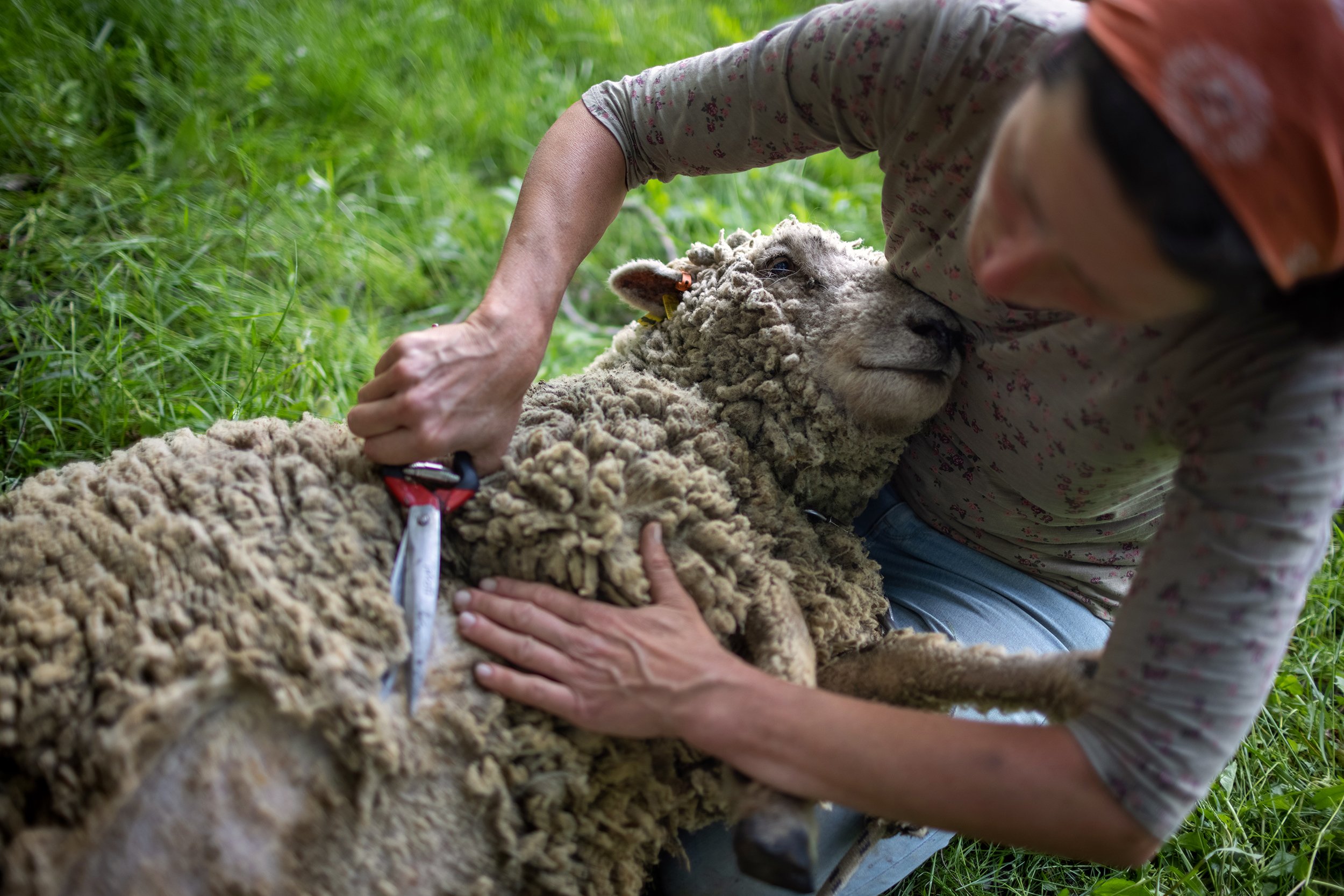
Sheep shearing. Nagyszékely, May 10, 2022.
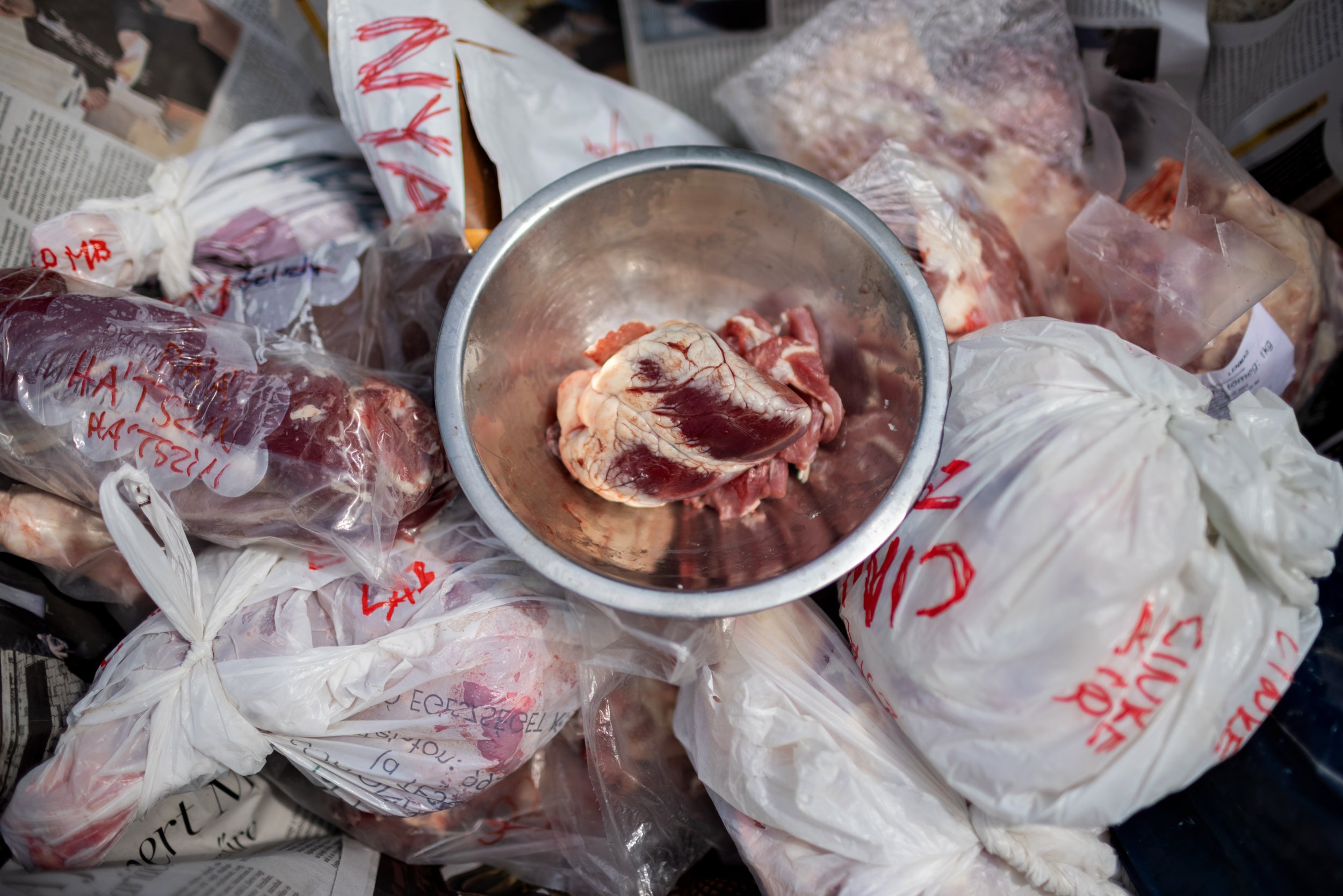
Meat from a freshly slaughtered lamb is carefully portioned and labeled in Nagyszékely on August 9, 2022. Not even offal and fat go to waste: the former is given to the dog, the latter to the titmice. There are many vegetarians and vegans in eco-communities, but the others can also be said to be much more moderate meat eaters than an average Hungarian family. Among the inhabitants of the ecovillage, it is not uncommon to eat only animals whose names they know.

Richness.
Seed bank in Nagyszékely (top left). Judit, a member of the MagHáz (Seed House) Association, stores professionally collected seeds of various plant species for preservation of species (or varieties), testing, and distribution. There are more than 500 plant varieties in the family collection, some of these are treasured landraces inherited from ancestors, others are self-collected or obtained from various gene banks, or exchanged with farmers.
Tomatoes in Nagyszékely (top right and bottom right). Etelka has more than 600 varieties of tomato seeds. Not all of them are planted at the same time, she is constantly experimenting with them: the summer garden is a cavalcade of shapes, colors, and flavors.

Playing circle game at the Új Koma Háló (network of Hungarian ecological local communities) meeting in Nyim on June 12, 2022. The presence of children sometimes interferes with adult programs, but as they are also seen as valued members of the community, some compromises are made to playfully involve them.

A sapling planted in February on the Eco-meadow on May 22, 2022. Straw placed on the tree’s plate helps to trap and retain morning mist and provides a habitat for tiny insects turning up the soil. The resulting small ecosystem helps the tree grow. Branches placed around it provide some shade and protection from strong winds. Mulched trees help both orientation within the area and attachment to the area because the character of the mulch heaps makes it easier to recognize parts of the area.

Saplings planted in February on the Eco-meadow on May 22, 2022.

Katja on horseback in Nagyszékely on August 16, 2022. The Ukrainian volunteer arrived in the Hungarian village from Kyiv in the spring of 2022, where she helped local farmers with plant production and animal care works until autumn. Because of her love of horses, she spent much of her leisure time on horseback.

Fanni and Dani in their ad hoc ‘office’ in Nyim on May 23, 2022.
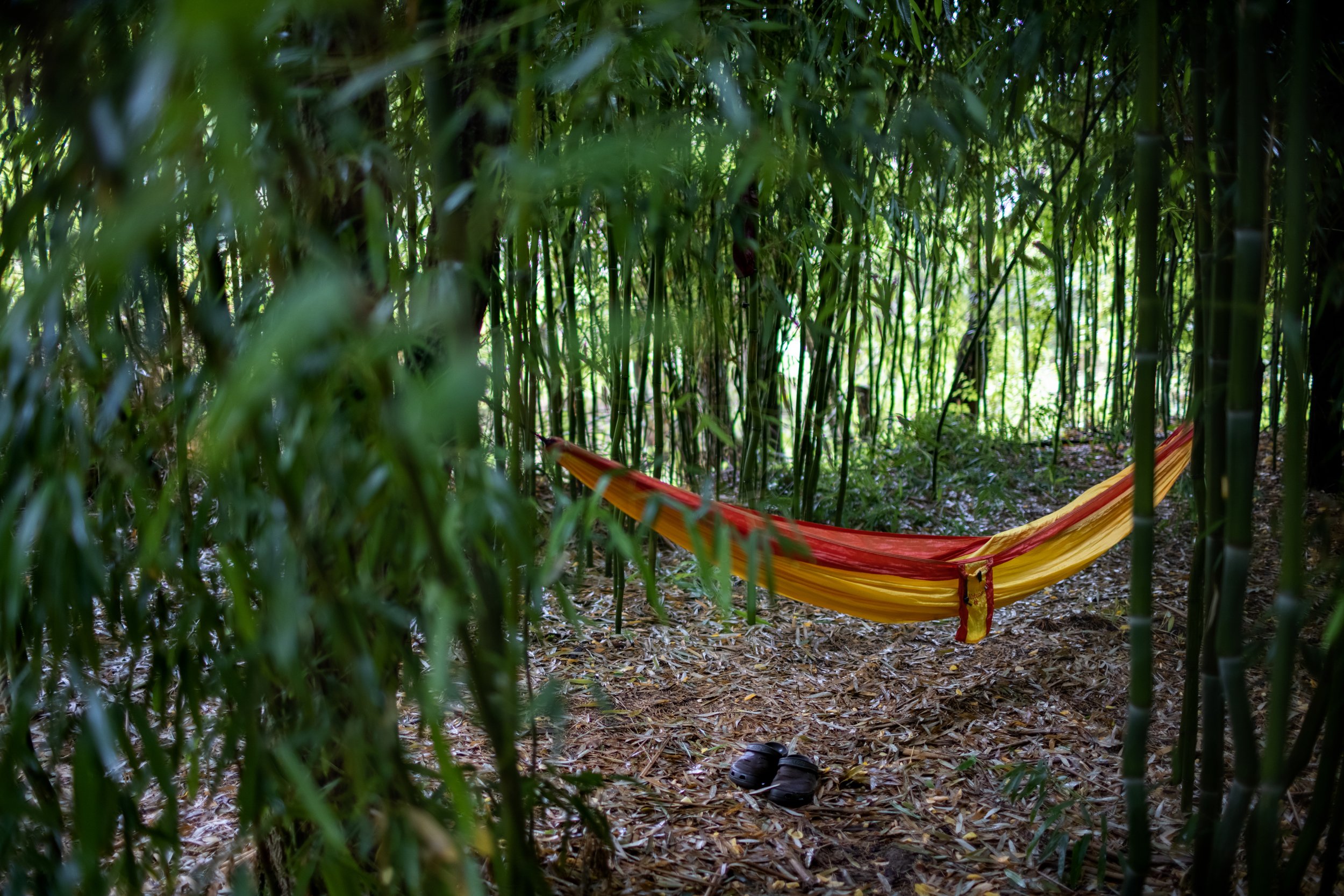
Bamboo-grove in Nagyszékely on August 9, 2022.

Its builders posing with the newly completed outdoor shower in Nyim on August 11, 2022. The structure is quite simple – consisting of a pallet, punctured bottles filled with water, and curtains hung on a tree for cover – but it can come in handy on a hot summer day when there are a lot of people waiting for a shower. The small structure was assembled by participants in the Permaculture Design Course (PDC). The term comes from the compound ‘permanent agriculture’, and it strives to develop systems that can work in the long term with the minimum possible intervention and without the involvement of external resources. In addition to its own educational programs, the Nyim Eco Community has for several years provided the venue (and the knowledge it has collected) for the Hungarian Permaculture Association’s training courses.

Virág having a rest with her pointing dog Kesu in Nagyszékely on August 8, 2022. The girl studying at the University of Veterinary Medicine has a particularly good knowledge of animals, both instinctively and through her studies. She knows that they are highly interdependent. Kesu is an effective watchdog, keeping wildlife at bay and alerting her immediately if anything unusual happens in the area.

Fanni Sall’s wire drawing in their garden in Nyim on March 13, 2022. With her works continuously being created and put out in the garden, the visual artist Fanni examines how her works can become focal points in the natural environment, how they shape the attitude of the observer and the creator toward nature, and their attachment to individual locations.

A participant warms up by the fire of the hastily built outdoor stove at the rocket stove building workshop of the Science of Nomad Life series launched in cooperation with a close friend of the community, Pál Szentgróti, and the community on November 5, 2022.

Some members of the Nyim Eco Community and one of their guests hold hands to thank each other for the food and the company on December 31, 2022, the last day of the year. In addition to maintaining ecological standards, the group’s primary responsibility is to reconcile the interests of the community with their personal goals. They hold meetings on a weekly basis, on Thursdays, continuously learning about active participation, listening to and understanding each other's opinions and positions. Decisions concerning their common affairs are made by consensus and recorded in writing. At the same time, disputes and disagreements (sometimes escalating to the point of moving out) occur, even despite the considerable energy and time devoted to community building.